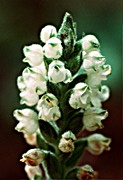Goodyera pubescens (Willd.) R. Brown
Downy rattlesnake plantain
The specific epithet pubescens is the Latin meaning "downy"
or "hairy," and refers to the downy hairs on the inflorescence.
Unfortunately, this is not distinctive, as all of our species of Goodyera
have downy inflorescences.

Photo courtesy of Mark Larocque
DESCRIPTION: Plant pubescent above
the leaves, 10-40 cm tall (including inflorescence), arising from a branching
rhizome supported by a cluster of slightly fleshy, fibrous roots, often
forming dense clusters of rosettes. Leaves 4-8, forming a basal rosette,
petiolate, oblong-elliptical to elliptical-lanceolate, 3-9 cm long and 1-3.5
cm wide, dark green or blue-green with a prominent white stripe along the
midrib and a prominent network of reticulate white markings. Inflorescence
a downy, dense spicate raceme 10-40 cm tall, 20-50 flowered, typically cylindrical,
each flower subtended by a small, lanceolate bract. Sepals ovate
to ovate-lanceolate, concave, 4-5 mm long and 3-4 mm wide, white and smooth
inside, the outer surfaces pubescent and often marked with green, lateral
sepals typically smaller than dorsal sepal and slightly spreading; dorsal
sepal connivent with petals to form a hood over the column. Petals
oblong or spatulate, 3.5-6 mm long and about 3 mm wide, closely appressed
to the dorsal sepal, white. Labellum deeply globular-saccate to scrotiform,
the apex prolonged into an blunt point (looking somewhat like a spout),
3.5-4.5 mm long and 3-3.5 mm wide, white, pubescent outside.
SIMILAR SPECIES: Goodyera pubescens can easily be confused with
G. tesselata or perhaps G.
repens var. ophioides. G. pubescens can be separated
from G. tesselata by the labellum, which
is concave in G. tesselata, but is deeply
globular-saccate in G. pubescens. Also, the leaves of G.
tesselata are smaller than those of G. pubescens, and typically
lack the thick white central vein of G. pubescens. G. pubescens
can be separated fromG. repens var. ophioides
by the inflorescence, which is secund or loosely spiraled in G.
repens var. ophioides, but is a cylindrical, densely-packed
spike in G. pubescens.
HABITAT: Goodyera pubescens is typically found in dry upland
oak or pine woods, usually in sandy, acidic soil. It is also found more
mesic woods; in the Baraboo hills I have frequently found it growing in
moist cool ravines under Hemlock. In this habitat, the plants frequently
grow out of clumps of moss.
FLOWERING DATES: July 15-September 5, mostly in late July.
POLLINATION: Homoya (1993) records
that he observed a small bee, Augochlorella striata, visiting (pollinating?)
flowers of Goodyera pubescens in Indiana. As Homoya points out, this
bee is also one of the species collected by Catling
& Knerer (1983) pollinating Cypripedium candidum.
DISCUSSION: Goodyera pubescens is perhaps the most common
orchid in southern Wisconsin, and is well-known to many for its distinctive
foliage. The leaves are wintergreen, and Keenan
(1992?) has observed that individual leaves last about four years.
WI DISTRIBUTION:  U.S. DISTRIBUTION:
U.S. DISTRIBUTION:
Go directly to Wisconsin herbarium records.
Return
to the main LIST of the Orchids of Wisconsin.
Return to the main KEY to the Orchids of
Wisconsin.

 U.S. DISTRIBUTION:
U.S. DISTRIBUTION: